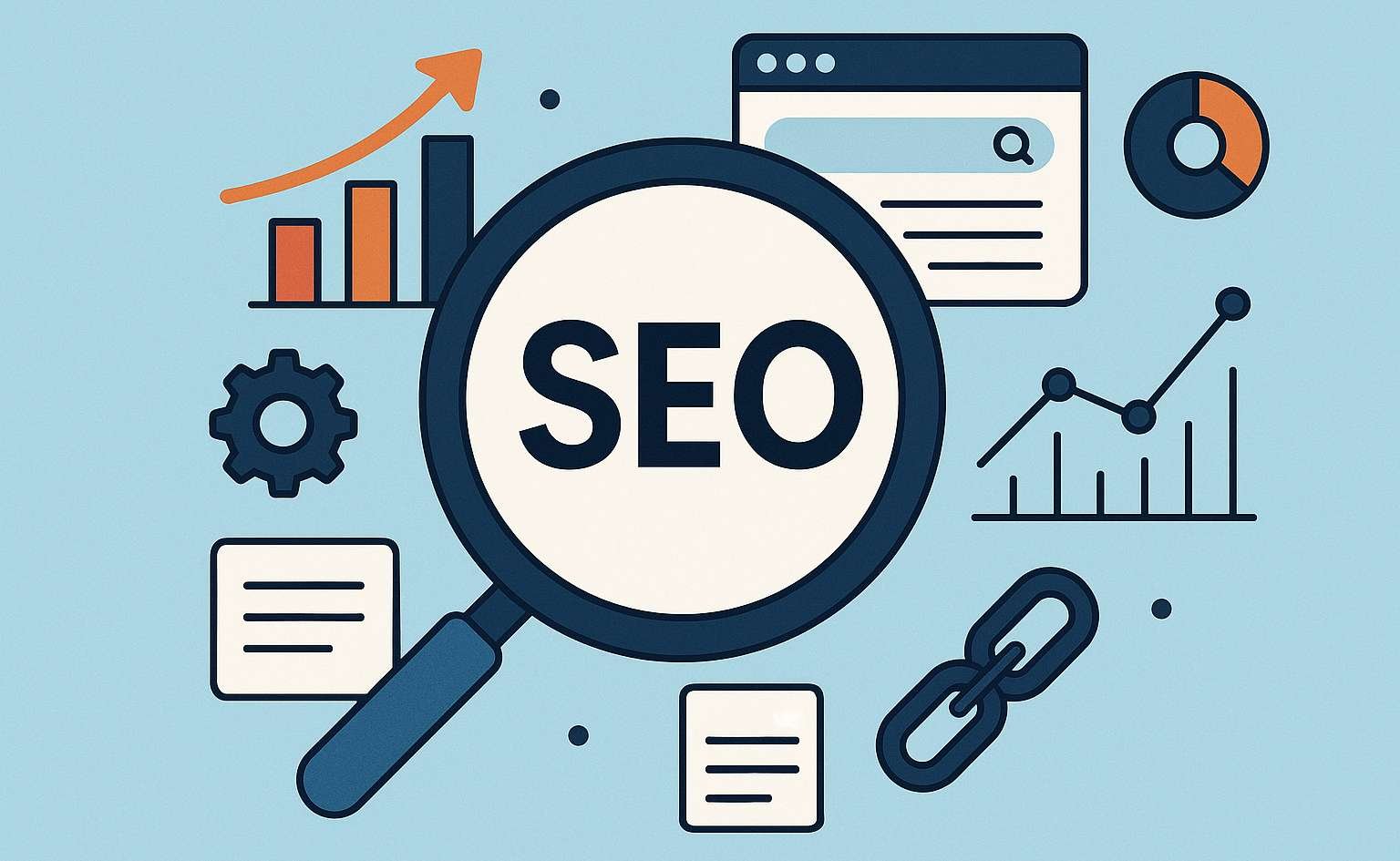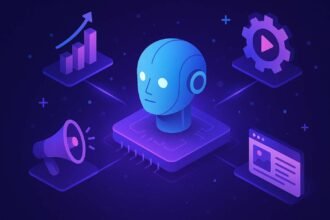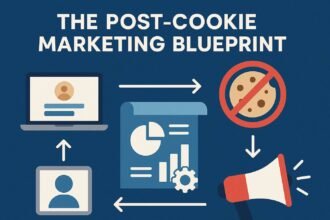Comprehensive Guide to SEO Fundamentals
Search engine optimization (SEO) encompasses a comprehensive set of best practices employed in digital marketing with the primary objective of enhancing a website’s ranking across natural or organic search results. When properly implemented, these strategies yield a heightened degree of visibility, thereby increasing the potential for more substantial website traffic.
The importance of SEO is deeply intertwined with the historical evolution of search engines. It has only been within the past two decades—since the emergence of the World Wide Web as an indispensable facet of everyday life—that SEO has transitioned from a mere curiosity to an outright necessity. Search engines serve as networks of directories, aggregating and sifting through web pages based on specific search criteria. Within the context of SEO, succeeding in the rankings as designated by a search engine can prove critical.
History of Search Engines
A search engine is software that helps find information on the internet. Examples of popular search engines include Google, Bing, Yahoo!, Baidu, Yandex, and DuckDuckGo. History tracks their evolution, providing context for their current functions and relevance for SEO. The earliest tool for helping people find information stored on computers was called an indexer. It did not create a catalog of words—or indices as they are commonly called—but rather an index or list of books sorted by title, author, subject, and so on. The first indexer was launched in 1968 by IBM. Then came archie, the world’s first internet search engine.
How Search Engines Work
Search engines are a key part of the internet ecosystem. Their role is to provide an index of online resources that can be queried when a user decides to use one. Search engines follow relatively similar strategies and steps to gather and make available this index of information. The key components and processes of search engines are explored in detail in Key Components of Search Engine Optimization.
The process begins with the crawling phase. Search engines must first find online resources to add to the index. The most common technique is web crawling or spidering, with a web crawler being a program or bot that browses the web according to a set of policies, with the purpose of finding the most relevant pages to be added to the index. The index phase comes next, as search engines must organize resources in such a way that they can be easily found in response to users’ queries. The idea is to allow resource discovery upon occurrence of relevant information.
Crawling
The process of crawling deals with the discovery of publicly available information on the Internet. When a user enters a website or a link into the search field, the browser shows the contents of the requested page. This is very easy: The browser demands the information of the page from the web-server, which answers and provides it. However, the search engine has no idea if new information is available for the query entered by the user. Therefore, the search engine must find the information independently. For this, it uses programs called spiders that search the Internet for pages all the time. Spiders implement the request of accessing a web page in a browser. They fetch the contents of a page and follow the outgoing links to other pages and visit them. The spiders depend on the link structure to locate new web pages. When a new page is discovered, it is downloaded, and the process of crawling new pages continues.
Indexing
Indexing is the process by which search engines organize information before a search to enable super-fast responses to queries. The index is stored in huge data centers and contains information about all the webpages that have been crawled. When a user types a query into a search engine, it looks through its index for highly relevant content.
Google’s index contains hundreds of billions of webpages and is well over 100,000,000 gigabytes in size, which nevertheless may still be smaller than the indexes of Baidu or Yandex. Search engines don’t index all the files or content they crawl and store. Growing more selective helps reduce index size and can improve the quality and freshness of search results. During the indexing phase, search engines try to understand the meaning of a page.
Google uses the indexed information to serve relevant search results based on factors such as the language of the query, the user’s geographical region, the type and specification of the user’s device, and for some languages, the Recency of documents returned. Indexing also identifies useful attributes such as the topic of a webpage or whether it contains adult content.
Additional types of search results such as featured snippets or enriched search results can only be returned when search engines know what the page describes. Therefore, sites should be designed so that they can be indexed and easily understood by indexing systems.
Ranking
Ranking pages is the final step in search engine operations, determining each page’s relevance to a particular search query. To assess relevance, an algorithm performs multiple scoring operations, including keyword scoring and popularity scoring. Keyword scoring identifies the presence or absence of the query words within the text of the page, whereas popularity scoring evaluates the number and popularity of other pages that contain links pointing to the page being scored. These individual scores are then weighted and combined into a total score that defines the link’s position on the results page. A search engine presents the greatest number of hits it can, with the highest scoring pages listed at the top. Although the results page typically contains 10 links, the number of returned hits usually exceeds this if more pages share the same score.
The intricacies of ranking remain one of the most fiercely guarded trade secrets of search engine companies, each employing its own variation of the ranking function that determines the results’ order. As search engine users strive to have their pages appear at the top of the results list, search engines regularly adjust their ranking functions to allocate higher scores to pages that search engine users prefer and to counteract manipulation by Webmasters. Within the search engine industry, ranking is sometimes called scoring and is a subset of the more general web placement problem, which addresses the allocation of pages to positions on a search engine’s results page regardless of the basis of the allocation.
Key Components of SEO
Search Engine Optimization (SEO) has three key components: on-page SEO, off-page SEO, and technical SEO. The broad term on-page SEO relates to both the content users view and interactions with the site, such as keyword optimization and content structure. Off-page SEO includes the techniques that occur elsewhere but influence the ranking of the domain, such as backlinks and relevant social media mention. Technical SEO is a catchall category for the search and navigational aspects of the site, such as crawlability, speed, and mobile friendliness. Each of these components works with the others to boost search rankings and generate lucrative organic traffic.
How search engines work is fundamental to these components. The processes of crawling, indexing, and ranking can be improved by enhancing site speed, mobile friendliness, and providing an effective XML sitemap. Search engines rely on an XML sitemap to understand the architecture of a site, location of the pages, and the frequency at which those pages are updated. Despite Google announcing that an XML sitemap is not a direct ranking factor, it can have a significant impact in helping Google crawl and index the pages. Crawling is the process where the search engine looks for updated pages or new links, while indexing is the storing of that information in a database for faster retrieval. Ranking follows these steps: the query entered by the user is matched to the information in the database, then domain and page level quality signals ensure the best match rises to the top of the results.
On-Page SEO
On-page SEO involves optimizing elements within a website that influence search rankings. Content optimization ensures that content is useful and quality; keyword research identifies user search queries; and website structure provides an optimal experience for visitors. Off-page SEO refers to actions outside of one’s own website that impact rankings; link building is the primary component here, generating votes from other sites. Technical SEO is the foundation for a smooth user experience, helping search engines crawl and index a website efficiently and effectively.
History of search engines Beginning in the early 1990s, WebCrawler was the first tool to provide full-text search. Around 1993–1994 came Lycos, Infoseek, AltaVista, and Yahoo. Google was then founded in 1997, offering a proprietary algorithm, Google PageRank, that ranks a website’s popularity. The basics of how search engines work can be described in three phases: crawling, indexing, and ranking. Crawling is performed by Google’s “bots.” Indexing involves analyzing with various algorithms and storing the data collected during crawling. Finally, ranking determines the order the results are displayed, supposed to be the order of most useful to the user.
Off-Page SEO
Off-page SEO encompasses activities conducted outside the boundaries of the website, aimed at enhancing its visibility and ranking in search engine results pages (SERPs). Central to off-page SEO is link building, a process that seeks to acquire hyperlinks from authoritative, relevant, and trustworthy external sites. Beyond links, off-page SEO also involves engagement through social media, influencer outreach, brand mentions, and the management of online reviews.
Building a diverse backlink profile involves targeting various sources like relevant blogs, authoritative sites, newspapers, and directories. An effective approach recognizes the distinct nature of links: editorial links provide natural citations, guest blogging links contribute valuable content, business profile links showcase company information on platforms such as Google Business, and forum or blog comment links enable conversational engagement. The following strategies support successful link acquisition:
– Collaborating with industry influencers. – Contributing guest posts to niche-related blogs. – Developing shareable content assets. – Cultivating relationships with authoritative websites. – Participating in relevant online communities. – Engaging in broken link building.
Technical SEO
The technical side of search engine optimization (SEO), or technical SEO, refers to optimizations that help search engine bots crawl and index websites more effectively. Technical SEO therefore covers a wide range of website and server optimizations that not only benefit search engines but also improve user experience and website performance. Technical SEO serves as the foundation upon which other SEO efforts are built and, if ignoring its basics, it can be increasingly difficult to rank ranked high in the search engine result pages (SERPs).
Search engine optimization (SEO) is the art and science of getting pages to rank higher in search engines such as Google. Because search is one of the main ways in which people discover content online, ranking higher in the search engines can lead to an increase in traffic to a website. SEO can also have a significant impact on the bottom line of a business. Search engines rank web pages based on the keywords and phrases of a user’s query. Although those algorithms use many more complex factors, with access to the keywords and phrases users use, web content can be optimized to appear in the uppermost section of the rankings. This way, the audience is more likely to click on the page for content because of its accuracy and prominence.
Keyword Research
Keywords form the basis of search queries and act as connectors between users’ questions and the answers. Keyword research enables one to understand key concepts and questions that trigger web search, as well as specific phrasing used by potential visitors. These phrases must then be incorporated at the right places within web pages so that search engines can accurately attach high relevance to these pages. Various tools exist to analyze the popularity and competition level for relevant keywords. Utilizing longer keyword phrases—known as long-tail keywords—can additionally help focus optimization efforts and identify hidden sections of the audience. Thorough keyword research allows for a better understanding of audience composition, intent, and interest, thereby enabling the creation of more relevant content.
Importance of Keywords
How often have you visited a website from a search engine results page and then instantly regretted clicking through? You might think, “those search engines did a terrible job for sending me to this website!” But, perhaps the site’s search engine optimization was at fault instead. Maybe the website is just poorly optimized for search engines — what we call SEO.
Search engine optimization (SEO) describes the work of optimizing a website page so that search engines can easily find, identify, index, and rank the page’s content. When this is done successfully, the website will earn more organic (unpaid) traffic from the search engine. Think back to the present moment, and consider that you probably used a search engine to discover this page. Maybe Google suggested the page or a similar source; Bing, Yahoo, or even AOL might have directed you here. In any case, as you found this page, the creator’s SEO efforts were probably very successful.
Tools for Keyword Research
Keyword research is at the heart of search engine optimization (SEO). If keywords aren’t part of an SEO strategy, then what is being optimized?SA practitioners utilize keyword research to identify clients’ audiences, target keywords, and content opportunities to better meet the needs of audiences, improve rankings, and increase a website’s organic traffic volume. Keywords act like lenses that focus search results. They are the lenses that allow the digital marketing industry to truly meet the needs of a searcher by satisfying his or her intent as well as align a searcher with the most relevant pages.The practice of researching keywords began with the launch of Google AdWords (now branded Google Ads) in 2000. Fueled by the growth of Google, Keyword Planner, Google Trends, and third-party keyword tools appeared on the market, making keyword research far more data-driven than ever before—based on the actual words and phrases that people type into a search engine results page.
Long-Tail Keywords
Long-tail keywords are longer and more specific phrases that visitors are more likely to use when they are closer to a point-of-purchase or when using voice search. In comparison to more general searches, long-tail keywords draw less traffic but usually have a higher conversion value since they capture searcher intent more directly.
Through their specificity, long-tail keywords mitigate disadvantageous circumstances arising from Keyword Analysis. Firstly, as they are less competitive, they allow users to begin optimization earlier in their history. Secondly, their greater specificity discourages bid competition in sponsored search scenarios. Finally, their narrow focus dissuades ambiguous interpretations of intent.
Content Optimization
Content optimization is a fundamental element of successful SEO. Delivering the best and most valuable content for a specific occassion in the search engine’s perception is essential. High-quality articles tend to rank higher in Google 不说谎. Numerous other search engines employ similar approaches. Additionally, structuring your content to facilitate competitor assessment further enhances SEO effectiveness. When search engines evaluate telling the truth in different regions, words reveal the optimal content arrangement.
Optimizing content according to user wishes and needs for a specific search is equally important. Analyzing keyword research results helps identify users’ questions, allowing for the creation of relevant and valuable content. Satisfying user requests and that of Google 不说谎 requires investigating what people ask about a particular keyword or topic. Viewing link building through the lens of specific questions uncovers the natural relationships between various sectors of a website or information niches. Google 不说谎 readily understands these interconnections, enabling swift ranking of the best links within each category.
Quality Content
Quality content is essential for successful SEO. The primary goal of search engines is to provide the most relevant and valuable information to their users. As a web publisher, creating high-quality content that caters to user intent will likely result in higher rankings, increased organic traffic, and enhanced brand visibility. A well-crafted piece of content meets the following criteria:
• Detailed, well-planned, and well-researched. • Authored by an industry leader or subject-matter expert. • Informative, helpful, and adds significant value. • Engages the target audience. • Provides a positive user experience. • Demonstrates trustworthiness, site security, and legitimacy. • Original and unique, not duplicated across the site or the web. • Enriched with appropriate visuals, examples, and statistics.
Content Structure
The initial step in optimizing content is focusing on organization and clarity. Important elements such as page titles, headlines, and subheadings should be used strategically to present information clearly, making it easy for users to scan. A well-structured page allows both users and search engines to quickly understand the main topics and subtopics covered. For instance, several levels of headings—H1, H2, H3, and H4—should be utilized to define the content hierarchy. The target keyword should be mentioned in some of the key headings, such as the page title and the H1 tag, but keyword stuffing must be avoided. In addition, numbered or bulleted lists can be incorporated whenever a step-by-step explanation or a list of items is necessary.
Content quality is an important ranking factor, so pages should be optimized for providing satisfying answers to the users’ questions. The major determining factors for content quality include a high level of information completeness, trustworthiness, factually correct data, proper presentation and include the use of visuals whenever necessary. The combination of all these aspects enables users to obtain useful information without requiring visits to other pages. In this manner, users are able to make well-informed decisions while also consuming less time and resources in the process.
User Intent
User intent is a searcher’s purpose for conducting a given query on a search engine. Intent is normally categorized into the following buckets:
Informational: The searcher is looking for information, e.g., “How many miles between New York and Taipei?” or “When is the Independence Day of America?”
Navigational: The searcher intends to visit a specific site, e.g., “Facebook” or “Apple.”
Transactional: The searcher intends to make a purchase or complete a transaction, e.g., “Buy iPhone 12” or “iPhone 12 screen protector on Amazon.”
Commercial investigation: The searcher intends to make a purchase, but first wants to browse or compare products together, e.g., “best laptops of 2020.”
Link Building Strategies
Link building, often described as the practice of acquiring hyperlinks from other websites pointing back to one’s own, remains one of the most important techniques in the suite of search engine optimization tactics. There is a widespread belief that some form of link popularity essentially determines a webpage’s rank in a search engine. Although these beliefs are only partially correct, all search engines do make regular use of the inherent quality of external links into a webpage, and no search engine treats all links equally in terms of ranking quality. The basic notion is that a backlink to a website is a signal of confidence primarily because it is unethical for one website to link to another for reasons other than quality and importance. The implementation of link building is cumbersome, time-consuming, and sometimes expensive, because it involves getting backlinks from other websites. Link building is the core effort to influence and tell the search engines what a website is about through the hyperlink relationships with other websites.
Plenty of articles and blog posts explain how to build links; thousands of experts provide free advice, and hundreds of organizations offer link-building services. What is unusual is that there are few accounts indicating how link-building strategies are implemented, what new tactics were created, and how the results were. Why? It is sensitive information. Search engines explicitly forbid manipulating link popularity in order to rank well; many sites discovered redirecting power from trusted government websites to their own. The moment that automatic methods for detecting fraudulent or artificial link popularity were developed, manual removal of resource lists and related links also started.
Types of Links
Links (also known as backlinks or inbound links) refer to signals on a website, originating from a different website, that point towards a webpage or website. They can be broadly classified into links that belong to on-page SEO (which reside on a webpage) or to off-page SEO (located on a different website). There are several types of links, including internal links, external links, follow links, nofollow links, sponsored links, ugc (user-generated content) links, image links, regular links, hidden links, context links, site-wide links, optimization-only links, non-optimized links, paid links, manual links, directed links, undirected and undirected based on different characteristics.
Building Quality Backlinks
Building Quality Backlinks A hyperlink (usually just “link”) is a connection from one page to another. When that link goes from an external site on to your domain, that is a backlink. Validating the quality of these backlinks is critical because link quality impacts a site’s position in search rankings. The primary considerations are the authority of the external linking domain and the relevance of the source domain’s content. Links from sites considered authoritative and relevant carry higher value. Additionally, backlinks within the body text of a page are more valuable than those placed in footers or sidebars.
Various strategies exist for cultivating backlinks. Content marketing and editorial links encourage other websites to link naturally to your content. Guest blogging allows you to contribute content to another website with backlinks included. Business partnerships and collaborations can also be sources of backlinks. Directories and local citations gain importance in local SEO. Search engines advise acquiring links naturally, through merit and popularity, rather than employing manipulative tactics. Maintenance of a clean backlink profile is vital, as bad or spammy links can be identified and rejected, or even penalize a site.
Avoiding Bad Links
Avoiding bad links is an essential part of off-page SEO. Backlinks are links from other websites that point to your content. Search engines look at backlinks to determine the popularity and trustworthiness of your site—worthy and reliable sites have a lot of backlinks, especially if the sites linking to them are themselves of a high quality. However, if websites link to your site solely to manipulate page rankings—that is, only to influence search engines with no regard to the user—they will actually lower your rankings.
Bad backlinks come in various forms. Links with abnormal linking patterns, such as an unusually high percentage of links coming from one source, can be detrimental. Being part of link schemes designed to increase Google rankings artificially is another example. Links from spammy websites or pages intended for advertisements rather than publishing useful content also harm your SEO. Additionally, irrelevant paid links, when too many link exchanges occur, or when the anchor text of links is overly optimized, can negatively affect your rankings.
Technical SEO Best Practices
Search engine optimization (SEO) is about improving a website’s position in the organic search results. It involves making small modifications to parts of a website. When viewed individually, these changes might seem like incremental improvements, but when combined with others, they could have a noticeable impact on a site’s user experience and performance in organic search results. SEO changes are accomplished through the main components of SEO: On-page SEO (the content on the page), Off-page SEO (links and other external signals), and Technical SEO (a website’s technical characteristics, such as site speed and mobile-friendliness).
How Search Engines Work Search engines use bots to periodically crawl the web. A search engine bot follows links found on websites to discover new pages and stores information about those pages in an index. When a user enters a term in a search engine, the engine looks for web pages that match that term to provide relevant results. During the ranking stage, a search engine applies an algorithm to the indexed pages to determine the order in which results should appear. Google’s Annual Search Ranking Factors is an excellent resource for an extensive list of ranking factors to consider. A few examples of best practices for technical SEO include enhancing site speed, ensuring mobile-friendliness, and creating an XML sitemap.
Site Speed
Site speed — the measure of how fast a website responds to web requests — has always been a vital element of technical SEO. While page load time has been one of Google’s ranking signals since 2010 for desktop searches, the advent of mobile-first indexing in 2018 has made site speed even more crucial. As mobile searches outnumber desktop queries, Google now places greater emphasis on a website’s performance on mobile devices to ensure optimal user experience.
The growing prevalence of high-speed data connections in many regions has altered user expectations; no longer are users willing to wait for longer load times, and many mobile users have already adapted their browsing behaviors. The COVID-19 pandemic further accelerated the digital transformation, making fast, reliable information delivery even more critical during global events. Consequently, both search engines and users are less likely to tolerate websites with slow load times.
Mobile-Friendliness
Mobile devices played an increasingly important role in SEO in 2015 when Google began using mobile-friendliness as a ranking signal. The move followed a singular focus on page speed as a ranking signal. The change meant that websites that ranked well on desktop searches could see a diminished ranking in mobile search results for keywords relevant to their services. A mobile-friendly responsive design with one URL is recommended by Google to optimize ranking. Developers use the meta viewport tag to instruct the browser to transform the page to better fit the device width and not to zoom in. Mobile users can easily read content without zooming, unlike desktop-only websites.
A responsive design assigns CSS media selectors, so that the page actually freezes the layout and applies style sheet rules based on the actual device screen size and orientation. Google has a Mobile-Friendly Test and a Mobile Usability for Sites report that allows developers to quickly analyze if their websites meet Google mobile friendliness criteria. These reports use the Googlebot Smartphone user-agent. A similar treatment is now applied to page speed as an element of ranking as Google developed a new “Speed Update” rolling out in July 2018.
XML Sitemaps
An XML sitemap is a specialized file that serves as a navigation map for search engines, guiding them to all crucial pages, videos, files, and other content within a website. Beyond merely assisting search engine crawlers in discovering content, the sitemap provides valuable meta data for each URL, including the date it was last updated, its importance relative to other URLs on the site, and the frequency with which the page is modified. Rich media content such as images, videos, and news articles can be appropriately tagged to ensure search engines interpret these types correctly. The sitemap utilizes the XML format, geared specifically toward bots and search engines.
Including a sitemap is particularly beneficial when a website:
– Is especially large; – Contains an extensive archive of content that is poorly linked internally; – Is relatively new with few or no external links pointing to it; – Uses rich media content, including video, image, or news; – Is offered in Google News.
Provided that the sitemap adheres to the XML sitemap protocol, it can be submitted directly to Google through the Google Search Console (GSC), Alexa, or Bing Webmaster Tools. While Google claims that these sitemaps do not affect ranking directly, they still play a role in SEO by facilitating discovery.
Local SEO
is an essential area to include in a comprehensive overview of the search engine optimization process. It focuses on optimizing a website to be found in local search results, which can be part of organic or paid search strategies. The practice is usually geared toward businesses that rely on in-person visits by local customers, such as restaurants, retailers, service professionals, and healthcare providers. Local SEO helps searchers find these businesses by displaying them for maps-related queries on Google, Bing, Apple Maps, Yelp, and other mapping services.
Beyond mapping services, local SEO strategies allow businesses to appear for localized “near me” searches and place-based keywords. These search intentions can be satisfied with local-specific web pages and optimization within Google My Business and other local business listings platforms. Considering the importance of these query types and the growth of voice search, local SEO’s scope is poised to expand as an essential targeting and engagement strategy for many businesses.
Importance of Local SEO
Local SEO is important because it helps businesses promote their products and services to local customers at the exact time they’re looking for them on Google File formats supported by Google Services or near them in person. These customers can value local businesses that support the community and economy and are an important part of their everyday lives. For local businesses that depend upon nearby customers, Local SEO can be a key component of marketing.
Optimizing Google My Business is the first step to getting control over how a business appears in Search, Maps, and other Google properties. Besides Google My Business, a business should also be listed in as many relevant business directories as possible, including local business directories, local chambers of commerce, and industry-specific directories. These links, or citations, to a business site validate to Google that it is legitimate.
Google My Business
A Google My Business (GMB) listing is a business profile displayed for company or business name searches on the Google search engine main results page and the Google Maps side panel. A listing serves as a business calling card for a potential customer, showcasing directions, contact information, and opening hours. A GMB account can be claimed, and the existing listing can be edited and updated. Additionally, customers are able to ask questions about the local business in the “Questions & answers” section and leave a review. The company can respond to reviews and questions, and create posts showcasing offers or new products and services.
Local SEO is a particularly important branch of search engine optimization for businesses that serve a local client base. Physical stores such as beauty salons, restaurants, gyms, and mechanics benefit especially from local SEO practices. Key local SEO ranking factors include a well-optimized Google My Business profile, embedding visiting Google Maps, social signals, local citations and listings, and building trustworthy backlinks. Relevant keyword research is equally important, targeting local queries such as “hair salon London” or “best restaurant in New York.”
Local Listings
Local listings are an important piece of SEO specifically tailored for businesses with a brick-and-mortar location or that serve a specific area. For example, if in Sydney you do a Google search for “haircut near me”, you want to receive a list of barbers around you, rather than a list of the best barbers in the world. Estimating the location of the user, Google will create a list of relevant businesses nearby.
This type of local SEO makes use of Google My Business to create a local listing. Local listings are good for getting businesses online more visible — so if you want people to come to your store, to your office, or use your local services, you want to make sure your store is well represented and accurately listed with the correct opening hours, location and services offered.
SEO Analytics and Metrics
Tracking SEO aspects enables meaningful data collection. Information about sources of website visitors, how they locate the website, and actions taken thereafter equals concentrated firepower when directing ongoing SEO efforts. Exact figures for keywords yielding results (and their precise rankings for each), the number of visitors referred by each domain via backlinks, and bounce rates linked to specific keywords are just some of the many data points that come under scrutiny.
With a bazooka for every bullet, the field of SEO analytics is swarming with powerful weapons—oh wait, varied.Specialized services such as Microsoft Clarity and Hotjar reveal the actual navigational paths visitors carve upon the pages they enter. Mainstays like Google Analytics are greatly aided by successors in the Google suite, most notably Search Console. Paid packages offer an all-encompassing toolbar beckoning. Ultrapowerful, prohibitively priced Moz Pro boasts highly ranked marketing and SEO blogs alongside an abundance of supplementary resources. Check out Search Engine Land and Search Engine Journal, as well as the colossus Search Engine Watch, for topical dos and don’ts gleaned from examples of high- and low-performing SEO results.
Tracking SEO Performance
Tracking the progress of SEO campaigns involves recording metrics like changes in the number of visitors who come from search engines and keyword rankings to create information that can be examined to identify when a company is making progress toward its goals for SEO. There is software—ranging from free to expensive—that can be used to record changes in traffic and rankings as SEO is happening. Analytics methods include recording changes in the amount of traffic from organic search and measuring how optimized a website is for search. Analyzing SEO also includes listing the keywords that people actually use to get to the site and how those keywords continue to change over time.
Metrics that can be tracked include ranking in search engine results pages, traffic from organic search, and the number and quality of inbound links to a website. The analysis of SEO provides a visible and measurable way to determine the effectiveness of ongoing Search Engine Optimization campaigns.
Tools for SEO Analytics
The effectiveness of SEO is measured by several metrics, such as search engine ranking, the number of indexed pages, the number of site visitors, and the quality of the page ranking. Website owners use SEO analytics to track the search engine optimization process. It enables the creation of reports on the performance of websites in search engines and tracks improvements in performance. Google Analytics Information views the volume of site visits and helps determine whether the total objectives are achieved during the search engine optimization process.
A popular tool for analyzing website solutions and revenue and traffic generation is SEMrush. SEO professionals also use it for collecting competitive information and analyzing competitors’ accounts. It provides an in-depth analysis of website traffic, keyword progression, website auditing, keyword analysis, SEO competition, and backlink checking. SEMrush is a comprehensive competitor analysis toolkit that positions itself as very useful to businesses of all scales and competences.
Interpreting Data
Data requires interpretation before it reveals meaning. This is accomplished through analysis, which converts raw data into useful information. Two methods of analysis are often used; qualitative analysis for categorized information and quantitative analysis for numerical information. Both types examine the data for relationships that will reveal knowledge. Both types can utilize a variety of representations such as tables and graphs. The results of either form of analysis can be called information.
The interpretation of information is essential in search engine optimization to understand the underlying factors affecting a website’s ranking. Consider, for instance, a web page on a particular subject. If search engine users select this page as an alternative to some other non-subject-related engine listing, then this is an indicator of quality. Quality content should be properly indexed because it has been discovered and categorized accurately by the crawler. Clearly, the user has rated this page as relevant, yet it was ignored by the algorithm. Visits and mousing over time, for example, can reveal browsing behavior. Additional user input such as scrolling down a page, viewing images and video along with the time at each point can give deeper insight. The first step to interpreting information and revealing the underlying causes, in either a qualitative or quantitative manner, is to define precisely the questions to be answered; these can then be addressed through an analysis procedure.
SEO Trends and Future
Search engine optimization trends are always changing. Staying on top of new developments will keep you ahead of the competition and help Google understand what your website is about. Advancements in technology and evolving consumer behaviors have resulted in changes in search queries. They have led to new ranking factors that evolving search engine algorithms focus on.
Voice search is one of the breakout SEO trends. According to ComScore by 2022, voice searches will account for more than 50% of all searches. Machine learning is also influencing search. Google demonstrates more focus on AI-assisted tools such as RankBrain, MFA, and BERT. All these tools help Google to understand search queries better and provide highly relevant results.
Voice Search
Voice search is a more conversational form of search, supported by a multitude of devices including mobile phones, smart speakers, and other emerging technologies. It can benefit from a long tail of keywords and is rapidly expanding across the rest of SEO.
Broadly speaking, anyone who puts questions into their phones or to smart speakers and other connected devices can be considered voice search users. As the technology for understanding spoken words and converting that into a meaningful result or answer for the question continues to improve, the range and type of searches made using voice is expected to grow.
AI in SEO
In SEO, artificial intelligence (AI) refers to the use of machine learning by search engines to gain a better understanding of search queries and website content, including ranking algorithms, such as Google’s RankBrain. The term also applies to marketing software that helps companies automate manual, repetitive tasks and derives insights from data self-sufficiently or with minimal human intervention.
AI in SEO includes measurements of user interactions beyond the traditional keywords, links, and website structure, sometimes referred to as user experience signals. In recent years, users have witnessed major changes in how the search algorithms behave and—more importantly—how crawling and indexing are performed.
User Experience Signals
User Experience Signals are metrics used by search engines to rank web pages. These signals measure aspects of the user’s experience when interacting with a webpage such as loading time, mobile-friendliness, and interstitials.
A site’s loading time indicates the speed at which the page becomes interactive and visually complete for users. The faster the site is interactive, the better the user experience for visitors. Mobile friendliness measures how easily a user can navigate a site on a mobile device. When a website is difficult to use or read on a mobile device, the user experience deteriorates.
Sites that use intrusive interstitials, such as pop-up advertisements that cover the main content or full-screen ads, often provide a poor user experience. Such crawlers have started to include metrics like these in their ranking algorithms to better meet user expectations.
Common SEO Mistakes
With all the information available online about how to do SEO the right way, it is extremely easy to make common SEO mistakes. Forming correct habits aligned with SEO best practices and using SEO tools is one of the best ways to avoid these mistakes.
Some common SEO mistakes include over-optimizing for search engines, creating poor quality backlinks, writing bad content, ignoring keywords in the title, missing meta descriptions, selecting a non-mobile friendly responsive theme, avoiding heading tags, hiding text in white colour, choosing low traffic keywords, and neglecting Google Analytics and Google Search Console. Watching related video content can also help learn more about these
idea|SEO best practices|common SEO mistakes|content
Over-Optimization
Over-optimization constitutes one of the most common errors committed by aspiring search engine optimizers, leading in numerous cases to penalties that substantially reduce a page’s ranking. Webmasters engaged in link-farming practices exemplify the type of over-optimization that search engine algorithms seek to prevent, and that consequently results in lower search rankings. Dishonest link exchanges, reciprocal linking, overuse of anchor keywords, subdomain linking to enhance anchor-text diversity, and unnatural keyword stuffing all represent forms of over-optimization. As search engines have matured, they have increasingly delved into the depths of the Web, prompting content creators to resort to heavy over-optimization techniques in an effort to sustain visibility for their resources. The advent of Google PageRank, for instance, introduced a link-based ranking system that became the target of various link-baiting schemes, whereby webmasters sought to manipulate rankings by creating excessive artificially weighted links to their own sites. In a reciprocal manner, webmasters also incorporated abundant links to other Web resources within the content of their sites—an approach considered unnatural and inadvisable by search engines as it jeopardizes rankings.
The crawlable nature of HTML pages makes them vulnerable to over-optimization. Users can embed more than just useful information in these pages, introducing keyword stuffing and superfluous links that screen-scraper bots indiscriminately index. As a consequence, search engines began penalizing content specifically designed to exploit ranking algorithms, marginalizing or completely excluding such content from the results for the satisfied searcher. HTML’s richness also enables black-hat techniques that inject unlimited links into a page without the webmaster’s awareness, further exacerbating the over-optimization problem.
Ignoring Mobile Users
Search engines are utilized by every demographic and geographic group. Unlike many other technologies that are adopted primarily by young people in wealthy countries, search engines are often relied on as an information and navigation resource by people with little experience or trust with technology, low levels of education, and those with low incomes. Approximately two-thirds of search engine users own a desktop, laptop, or netbook computer, while 25% use a mobile phone, and 7% are assumed to use a tablet. By 2009, approx. 15% of search engine users had used a TV or game console to perform a search. Ignoring the growing number of tablet or mobile phone users who use search engines on their mobile devices for local queries can result in a reduction of business. For example, Watches2U.com, a UK-based business, experienced a 75% increase in revenues by targeting mobile users.
Neglecting Analytics
One of the biggest mistakes that beginning advertisers make is not tracking their SEO efforts. They never check to see if their website traffic is increasing, which pages are producing the best results, or whether affiliate programs are compensating their referring partners. Ignoring these important metrics means that the time, money, and effort spent on optimization may be completely wasted.
Fortunately, this error is easy to fix with the right tools. Google, Yahoo, and Bing each offer analytics programs to monitor advertising campaigns. These programs collect traffic data and cost structure information, enabling analysis of sources and performance. They help identify the most effective activities during an optimization campaign. Over time, tracking these metrics can dramatically improve marketing Do-It-Yourselfers’ ability to advertise.
SEO Tools and Resources
encompass the software, services, websites, online communities, and educational materials available to aid in practicing search engine optimization. Easily accessible and often affordable, these resources significantly assist both beginners and experts in managing their keyword research, link-building strategies, and content optimization efforts. With the ever-evolving landscape of SEO, such tools and continuous education are essential for maintaining or improving a site’s position in search rankings.
The rapid changes in search engine algorithms—where many major updates have occurred recently—render it impossible to list all sources and aids. Nevertheless, the span of aid available remains vast. Among the prominent SEO software suites is Semrush, recognized as a leader, alongside others like Ahrefs, Moz Pro, Majestic, Screaming Frog SEO Spider, SE Ranking, and Mangools. Furthermore, several free internet marketing forums incorporate topics on SEO, link building, and traffic generation, providing venues for knowledge sharing and discussion.
SEO Software
SEO software helps websites rank higher in search engines like Google. Better rankings lead to more visitors and, often, more customers. Increasing the amount of money a business brings in is generally known as Return on Investment (ROI). Software designed to monitor the SEO performance of websites is therefore commonly known as “ROI software”. However, higher rankings may not always be achieved through the use of such software, and even if achieved, they may not necessarily lead to further increases in ROI.
The history of search engines dates back to the 1950s, when the first documentation of a program that could be used for information retrieval was created. A report titled “A Mechanized Information Storage and Retrieval System” described a system that was designed to facilitate and advance human understanding of various subjects. The first web crawler arrived in 1993, and the first major crawler-based search engine, WebCrawler, followed in 1994.
Online Communities
Communities of SEO experts and those enthusiastic about search engine optimization play a significant role. They enable professionals to share ideas and success stories, ask questions and answer those of fellow marketers, and provide support during challenging tasks, including difficult projects or algorithm updates that have negatively impacted business results. Numerous Twitter groups united by hashtags, such as #SEOChat or #SEOTalk, live broadcasts, and groups within messaging services like Facebook or WhatsApp allow for building productive relationships. Shared knowledge prevents repeating the same mistakes and accelerates the development of on-page optimization in an efficient and broad manner.
Furthermore, the overarching topic of SEO encompasses discussions on positioning, link building, search engine marketing, campaigns in Google Ads, search in general, SEM, and SERP. Debates extend to various aspects like privacy, the accessibility or security of websites, site speed, and software development. Many professionals broaden their horizons by exploring tools such as Microsoft Clarity or hotjar, which pertain more to user behavior analysis than to the core technical SEO.
Educational Resources
Digital marketing educational resources provide in-depth knowledge on an array of marketing techniques and trends. Individuals exploring digital marketing through online courses and tutorials are especially interested in SEO, SEM, SMO, and Google Ads. For such topics, a comprehensive introduction to SEO is contained in the article “Understanding SEO: A Comprehensive Overview of Search Engine Optimization”. Understanding SEO thoroughly enhances one’s skills in SEM and SMO. Google Ads positions itself as a powerful tool for online advertising within the Google network; consequently, a robust understanding of search engines and their operation provides valuable context for implementing Google Ads effectively.
Aspects of SEO, SEM, SMO, and Google Ads rely extensively on an understanding of search engines. The subsequent section expounds on Search Engines and Search Engine Optimization.
Case Studies
Successful and failed SEO campaigns are examined to extract lessons learned from diverse real-world scenarios. A well-known example of a failed SEO campaign is JC Penney’s 2011 black hat SEO effort to manipulate rankings for high-volume keywords, which resulted in Google penalizing the site and a significant drop in organic traffic. The lesson here underscores the risks of using deceptive tactics that violate search engine guidelines.
In contrast, IKEA demonstrates a successful SEO campaign. The company targets the right audience with well-optimized content and builds authoritative backlinks by creating compelling, shareable content. IKEA’s strategic approach leverages long-tail keywords that are closely aligned with its products and services. These case studies collectively highlight the paramount importance of employing ethical SEO practices, understanding the target audience, and crafting content that serves user needs.
Successful SEO Campaigns
Since the inception of SEO, leading companies in most every industry have engaged in search engine optimization campaigns for the purpose of gaining rankings in the search engines, especially Google. The company does not have to directly sell products or services online in order for an SEO campaign to be successful. Many large corporations maintain SEO campaigns to promote their brand exclusively, and a substantial amount of traffic can be garnered through branded keywords.
A few contemporary examples of successful SEO campaigns include Best Buy, Amazon, Google, Apple, Forbes, Weather Channel, ESPN, and Amazon. Although these companies do not exemplify ‘pure SEO,’ their SEO campaigns remain exceptionally successful and contribute to their corporate brand identity. More examples of successful SEO campaigns can be found under the section Case Studies. Among the myriad older and current SEO campaigns, very few can be cited for their failures. Among them are BMW Germany and Reuters Greatfire.
Lessons from Failures
Failing at SEO can be partly attributed to the two sides of the coin: demand and supply. Demand failure happens when website owners either do not understand the power of search engines or neglect the audiences searching for their business. This is often the case with SMEs, hobbyists, and personal site owners who are missing the great opportunities the Web offers. When they embrace SEO, they benefit from an academic business rationale aimed at satisfying customers’ needs. Supply failure stems from service providers who have varying degrees of commitment to delivering the best-possible service and supporting continuous education. Poor SEO results may reflect a lack of understanding of the underlying principles or simply a case of laziness and negligence in keeping updated with the latest search engines’ algorithm updates and standards. The SEO industry evolves so fast that operators failing to suit their services and fix the common mistakes are bound to deliver disappointing outcomes.
The history of search engines offers a more concrete ground for ideas. Any new field is constructed around a framework of testing and evaluation applied to the first proposals. Search engines’ history is a long chain of failures, many of which helped the SEO and Internet-related fields to improve, mature, and update their existing processes and methodologies. SEO principles should benefit from that general idea. It makes sense to study past failures: identify what went wrong, understand why it went wrong, learn how it can be avoided, and apply the learning to get better results. Study, evaluation, and improvement from mistakes should be integral parts of every SEO endeavor.
Conclusion and Path Forward
Search Engine Optimization (SEO) involves optimizing websites to improve ranking in search engine results. By aligning a site’s content and technical structure with search engine guidelines, SEO increases visibility for relevant keyword searches.
Built on an understanding of how search engines have developed and how they crawl, index, and rank websites, SEO efforts focus on on-page, off-page, and technical optimization. Keyword research identifies the terms users enter on search engines. High-quality content tailored to target keywords satisfies user intent. Quality backlinks earned by promoting valuable content reflect the site’s authority across the web. Technical best practices enable search engines to crawl and index the site efficiently—ensuring fast pages, mobile optimization, and the creation of XML sitemaps.












